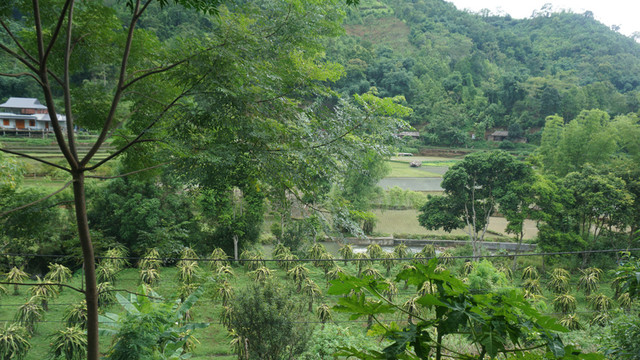If you want to go far, go together
How do poverty and vulnerability to climate change overlap? If you're to tackle either issue in urban contexts how must you engage with the other? How can practitioners in cities, in national government agencies and international organisations support urban development that reduces risk and boosts low-income residents' standard of living? And how can community-led processes reduce poverty and build resilience?


New construction sites for housing have been prepared by the government on the hillside above Nhon Hai, but the compensation isn't enough to let people move (Photo: David Dodman/IIED)
IIED staff and partners from Vietnam grappled with such questions last week in a workshop in Quy Nhon.
Towns and cities in Vietnam have been growing rapidly and the transition towards a market economy has reshaped relationships between citizens and government agencies. Urban poverty has been decreasing, according to national poverty assessments, but there are concerns about the accuracy of such measurements. Poor quality housing conditions and the exclusion of migrants from much of the analysis are two frequently mentioned problems.
At the same time, climate change means that more of the country has been experiencing cyclones, and that the many coastal cities along the coast are increasingly exposed to sea level rise. Taken together, urban change and environmental change create a complicated mix of uncertainty. Reducing poverty and building resilience within this mix will require new strategies.
Working together
Both poverty and climate vulnerability are composed of multiple different elements. In some cases these clearly influence, and can be addressed alongside, one another.
We saw this in a visit to the fishing community of Nhon Hai in the eastern part of Quy Nhon City. Landslides and coastal erosion have caused loss of life and destroyed livelihoods for those living near the beach. Climate change and sea level rise are expected to make the situation worse in the future. New construction sites for housing have been prepared by the government on the hillside above Nhon Hai – but the government compensation isn't enough to let people move.
However, the affected community has not stood by idly – people have organised themselves into savings groups, which have in turn been able to mobilise additional funding from the Asian Coalition for Community Action (ACCA). Loans from ACCA funds will go some way in helping to cover the shortfall and in enabling people to reconstruct their own houses on this safer land — land that is still close enough to the beach for them to continue fishing.
The situation in Nhon Hai illustrates many of the experiences of the community members and professionals who took part in this week's discussions, and helped us draw up summary points that answer some of the questions posed above:
- Climate-related hazards can be a key factor preventing people from lifting themselves out of poverty, and can pull the 'near poor' back into poverty – by destroying their accumulated assets or by absorbing funds into housing repairs that could otherwise be spent on more significant improvements
- Access to land is critically important to reducing poverty and building resilience in densely-settled urban areas. Location, cost and tenure security are all crucial: where people's livelihoods are tied to a particular place they need to be able to access this without consuming valuable time or money. Finding the right land often requires intervention from local governments to provide plots at no or low cost. Residents also have to recognise and be willing to respond to risk where this exists
- Effective interventions are helped by innovative financial mechanisms that draw on community savings to bridge the gap between low-income people's needs and their ability to pay. The community residents we spoke with shared their experiences of organising, and of bringing together different sources of funds – with daily savings of between US$0.10 and US$0.50 forming a central pillar that can be combined with a Community Development Fund and contributions from local government
- Improving low-income urban residents' quality of life requires them to be included in decision-making processes in a meaningful way. In turn, this requires building trust between local governments and community organisations. The uncertainty around future climate impacts may make this even more difficult. Communities and local governments alike must try to make sense of the probabilities of different scenarios arising.
Crucial to all these actions is a community-based process that brings people together to achieve much more than they can on their own. This is particularly essential in addressing the underlying drivers of both poverty and vulnerability: both issues need a long-term view.
Equally crucial is much more collaboration: between networks of people working on urban poverty and climate change, and between such networks and local government. This point was captured most effectively in a proverb shared with us by one participant: "If you want to go fast, go alone; If you want to go far, go together".
David Dodman (david.dodman@iied.org) is co-head of IIED's Human Settlements Group, a senior researcher in our Climate Change Group, and leads the institute's work on climate change and cities



